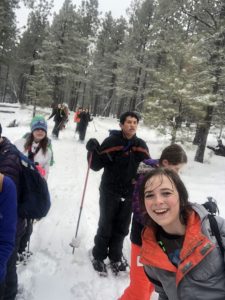Movie Snow and Jello Frogs

It was the kind of outing we aspire for every time we take our students out. Magic was happening December 6th, 2018 when 19 students from the Montessori Charter School of Flagstaff bundled up in their winter best and made a trip to the Flagstaff Nordic Center.
Our first and most important goals was to teach the students about insulation, staying warm, and layer management. We discussed in class how animals prepare for winter. Storing extra energy (food!), Adding extra fur layers (Coats! Base Layers!), seeking shelter (Wind protections and insulation!) helps animals get through the winter and it can help us too!
The big key to insulation of course is the air space, something we will learn more about later, but for now it is time to layer up, put on our waterproof boots, and head to the Nordic Center. Here our young adventurers were fitted with snowshoes and helped each other figure out how to put them on, getting the straps as tight as possible.
We headed out to snowshoe on the designated trails stopping to shed or add layers as needed. Layer management is key to winter comfort as wet, sweaty shirts make for cold wet shirts soon enough. Dry is warm!
Once we found a nice spot in the forest we set about learning more about snow science and winter survival. First students were tasked to create a den for their own hibernating animals. Jello Frogs. Jello is mixed with hot water in a tupperware and each group must design a den to insulate their frog well enough to survive the winter. If, in 45 minutes the jello is still liquid, you frog survived the winter. If it turns solid, oops, your frog didn’t make it. The good news, of course, is everyone gets to eat jello in the end! Using what they had learned about air space and insulation the groups each constructed their dens.
With Jello frogs safely snuggled in the dens, we set about learning to look more closely a snow crystals. Different shapes and structures indicate temperatures, water content, levels of disturbance and relative stability of the snow structure itself. Students looked at snow falling from the sky, underneath other layers, on the trees, everywhere.
It was now time to check on our frogs. Half of the frogs survived, and half got a bit too cold. Upon reflection, the class was able to identify what may have gone wrong. Too much air space, not enough air space, more layers of insulation needed.
Last, we put our learning into action building snow forts that we might want to sleep in. While we didn’t quite have time to get our snow caves polished to perfection we had a lot of fun, experienced the work it would take to make a home of snow, and happily snuck in a little snowball fight too.
As we hiked back out to the lodge, one of the teachers commented that we were experiencing “movie perfect” snow. We sure were. Big soft flakes that floated silently and persistently to the ground. Perfect snow. A perfect day.




























